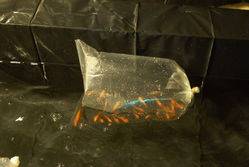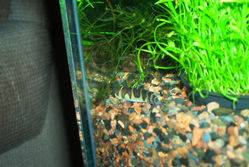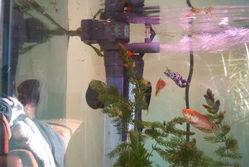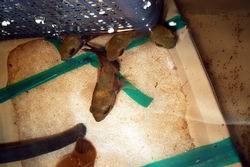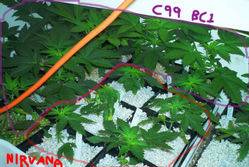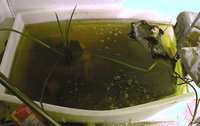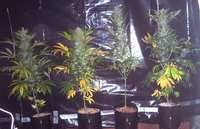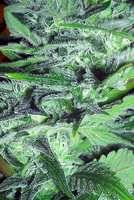G
Guest
Hello IC magazine!
Gypsy's asked me to submit an article for the print mag, and I just happened to have some old bits about aquaponics kicking around... it's a little dated now but I still like it... whaddya think?
"Most gardeners agree that a good hydroponic system will produce larger, heavier plants than a soil-based system. But with traditional salt fertilizers the grower must frequently drain and refill the reservoir, necessitating the disposal of water that is rich in nitrate and phosphate. While many gardeners, such as myself, use this runoff as a supplement to an outdoor organic garden, those who lack yards or sunshine must pour it down the drain. While this is quite literally a drop in the ocean of water pollution generated by the monocultures of industrial agriculture, it does still offend the sensibility of the environmentally minded and in any case nutrients are expensive. The recent trend towards topping off with a dilute nutrient solution, and completely changing the reservoir rarely if at all, is a logical step but one is still locked into purchasing expensive solutions of inexpensive salts, as well as running the risk of a cumulative disorder caused by differential nutrient uptake-- zinc toxicity for example. The solution (ha-ha) is a biology-based system that generates nutrient ions in situ and is reactive to induced imbalances. I speak, perhaps with unnecessary complexity, of aquaponics and as I am about to turn over half my garden to the fishies and the bugs, I'd like to ramble on a bit about what I'm going to do and why.
This is part of a larger redesign of the growroom. Here is the "control" side, which will run a standard GH solution with Dynagro Pro-Tekt added. It is essentially a 16-site bubbler with a common reservoir and one 8" airstone per plant. The pots are 10" square and 8" deep. One row is filled with Hydroton, one with perlite, one with perlite on top of hydroton, and one with a mix of perlite and hydroton. I am hoping the perlite shows well against the hydroton as it is much easier to procure and dispose. I changed to the large square pots to give the roots something to hold onto as well as make it easy to move individual plants in case of disease or to give a more even canopy. This garden will be completely from seed, as the fridge is overflowing with fresh little gene packets! For the past few months I have been infatuated with the yield, aroma, and high of Breeder Steve's Sweet Tooth #3 so I have procured and produced as many crosses as I could get my grubby little hands on: a c99/Ortega cross, a Bubblegum cross, plus a homemade hybrid made from a ST3 dood and a lovely Hawaiian Sativa x Cotton Candy female from Federation. Not using clones means that I will not be able to get meaningful data regarding yield, but hopefully the overall vigor and average yield per plant will give indications of the differences between hydro and aqua. The water level will be about 1" above the bottom of the pot to start, eventually to be lowered to about 1" below. Seeds are vegged in a modified cheapo-aero unit. Light for bloom comes from two 1k Hortilux in aircooled SunSystem hoods on a Light Rail 3.5. CO2 is kept above 1350 ppm by a digital Control Wizard controller, which also interfaces with a thermostat to turn on the exhaust fan at about 30C. The air is drawn through a snorkel-type duct going into the first light, which siphons the hottest (and therefore moistest) air from the top of the room, through both lights, and into the attic where a homemade Greenman-type ozone generator runs for 1 minute every 4 hours. This is not the most efficient means of CO2 enrichment, that would require running one duct circuit for the lights and another for the room. That means two fans, as well as a sizable intake hole for the lights that I cannot provide. Fortunately, we have gas heat and stove, both unvented, that make the ambient air between 800 and 2100 ppm. The Control Wizard measures this and makes up the difference from a bottle.
The true goal of this experiment is the creation of a circuit that is almost totally closed... I've recently discovered that I can take my roots and stems, compost them in a bin on the back porch with the rest of the kitchen waste, then take the worms from the bin, feed them to my fish, and then use the fishwater for the plants. I generate less trash destined for the landfill, spend less on pricey live foods, and have a constant supply of rich compost. Also it is difficult for me to safely move large volumes of used medium and roots in and out of my home-- especially in the middle of winter!
Today the liner was laid for the aqua half, the biofilter installed and 50 little feeder goldfish were introduced. I chose to start with goldfish for several reasons, primarily because they are hard to kill. Goldfish can tolerate colder, dirtier water than tropical fish and are more resistant to disease as well. Goldfish also produce quite high levels of ammonia, up to 100 mg per kilo of body weight each day. Ammonia is a form of nitrogen that should be converted to nitrate by bacteria before being used by the plants. The primary function of the filter in the third picture is to sustain a thriving culture of these bacteria, which live on the rotating grey paper wheels. These bacteria require high levels of oxygen, near-neutral pH, and temperatures above 65F. The key to this system is to keep these bacteria happy. The filter provides the oxygen but the pH and temperature are up to the grower. The plants prefer a slightly acidic 5.8 or so but the bacteria like it about 7.5 and in fact will die below 6.0. I will compromise and keep it between 6.2 and 6.8. I use phosphoric acid for pH down as phosphate is more or less nontoxic to fish. To raise the pH, which is more frequently needed, I use regular GH pH up, which adds a bit of potassium to the mix and is perfectly safe.
Traditional aquarists shun anything containing phosphate, as it encourages algae growth, but for the aquaponicist it is a bonus as you can recruit a crack team of scavengers who like nothing more than nibbling fresh algae and breaking it down into available plant nutrients. Let’s meet some of them now…
These are my two plecostomuses, or plecos. They are armored catfish from the Amazon that are very hardy and quite cheap as well, about $3. They are not as cold-tolerant as goldies but will be fine down to about 65F, which is a bit cooler than optimum for hydro anyways. If you have a decent size tank, you can frequently pick up large orphan plecos for next to nothing at your local fish store (hereafter LFS.) They grow to about 18” within a few years, and a catfish that size can eat a LOT of algae. However do keep in mind that plecos need a chunk of driftwood to chew on; it is a source of fiber that aids digestion, and a constipated fish is an unhappy fish! These guys were both given to me, along with their delightfully improbable monikers of “Marcus” and “Dr. Krypto” … any resemblance to certain OG staffers is purely coincidental.
And here we have some corydoras catfish, also from the Amazon. These little guys are just so damn cute! They will be OK with a temperature of 70F, plus they are happy to pick through the detritus on the bottom to find their meals. I give mine algae wafers as well.
Let’s say you’ve decided to have a group of goldfish and a plecostomus for your little fertilizer factories. So how many are you going to need? There is no set answer for this question, rather you’ll have to read the health of the plants, and the fish, and decide how heavily you want to stock your tank. The rule of thumb for a standard tank is one inch of fish per gallon of water, so consider this the lower limit since you’ll have excellent nutrient removal with your plants. Hassan the anointed likes to overstock his tank and then wait for the population to stabilize naturally, in other words only the strong survive!
When selecting your goldfish, do not get the smallest feeder fish available. Although cheap at about 8 for a buck, they are often kept in unsanitary conditions and can be vectors for disease. Preferable is to spring for the 50-cent goldies that are a little bigger and generally sold with the idea that they will live longer than a couple of hours.
This is probably a good time to talk in a little more detail about the ammonia to nitrate conversion I mentioned earlier. Fishkeepers talk of this process as The Nitrogen Cycle and understanding it well is crucial to the health of your system. The essence of the Cycle is that nitrogen can exist in three forms in your tank: ammonia (NH3), nitrite (NO2-), and nitrate (NO3-). Ammonia is quite toxic to fish, nitrite slightly less so, and nitrate is essentially harmless. Incidentally ammonia is less toxic at slightly acidic pH, 6.8 and below, but since that is the upper limit of our desirable range anyways that is not so important.
Fish need a lot of protein in their diet and most fish foods are about 35% protein. Protein is composed of long strings of amino acids, so called for the inclusion of an amino (NH2-) group in their structure. After fish have digested the protein, those aminos are expelled into the water as ammonia. Here’s where it gets interesting: there is a class of bacteria, called nitrosomonas, that like nothing better than to chew up NH3 and poop out nitrite, or NO2-. Nitrite (note the ‘i’) is still toxic, but hold on! Nitrosomonas have cousins called nitrobactors that will gladly eat their friends’ waste and expel soft, gentle nitrate, or NO3-. Nitrate is not only nontoxic to fish (at reasonable levels) but it is also the form of nitrogen recommended for the healthiest plants.
There are products that claim to have these bacteria in a jar but I have not had success with them. You MUST have a healthy bacterial culture before you fully stock your tank, otherwise NH3 will quickly rise to toxic levels and suffocate your fish. The gills function as both the lungs and kidneys of the fish so it is imperative that they see mostly clean water. The most common method of cycling a tank is to start out with one or two fish, then waiting about 14 days, then adding more stock. Even then you may not be able to immediately fully stock the tank as the biological filtration could be overwhelmed, but once the culture is established it will grow quickly to fill your needs and you should be able to fully stock the tank within another week or so. There is a shortcut around this process, called Fishless Cycling, that basically consists of setting up the tank, then adding a teaspoon of common clear cleaning ammonia every day until the tank has cycled.
“But Shipperke”, you ask, “how will I know when the tank has cycled?” The answer, my friend, is that you will need to invest $20 or so in some diagnostic tools that will allow you to accurately measure the ammonia and nitrate levels in your tank. Even if the only fish you allow in your house comes breaded in a paper box, these tests will allow you to ensure that your plants always have an adequate supply of this crucial nutrient. With some plants the need for N is greater than for all the other nutrients put together, so it will behoove you to ensure that there is always at least 50 ppm, and preferably 100 ppm, present in your solution. Many books, websites, and fish professionals claim that nitrate should be kept below 30 ppm but this is unnecessary. 100 ppm is absolutely safe for any species of fish, as long as ammonia and nitrate are kept at zero by the biofilter. Here’s two professional opinions on the matter: I know two fish store owners, one sells highly inbred exotic fish that start at $100 and he tells me that pH and ammonia are the only factors to worry about, and nitrate doesn‘t matter in a freshwater system. The guy at the other store sells fish in the five to twenty dollar range-- but lots of test kits and filters and stuff-- and he swears that you need to keep the nitrate under 50 to keep the fish healthy.
There are two types of tests, strips and liquids. Strips are OK but they degrade over time. The liquid tests are a little more expensive and are generally regarded as more accurate and reliable. Also, many fish stores will do these tests for free, or for a modest fee. So when you add your first fish, you will see NH3 levels rise for a few days, then level off and start to decrease. This indicates that nitrosomonas are establishing and producing NO2-. You can test for NO2- but unless you are in a big hurry it is unnecessary. Once NO2- levels start to rise, you should see a similar pattern as nitrobactors become established and begin producing nitrate. At this point the bacteria will begin reproducing at an exponential rate, assuming that your filter has plenty of surface area and oxygenation, and ammonia and nitrite will soon drop to zero as nitrate accumulates.
I cannot overstate the importance of biological filtration. Do yourself a favor and check out a couple of these sites, they have figures and charts that explain better than I can in words:
http://faq.thekrib.com/begin-cycling.html
http://www.aquariumfish.net/informa...ration.htm#top2
http://www.thetropicaltank.co.uk/cycling2.htm
(Even if you are down with the Cycle, all three of these sites kick major fishkeeping boo-tay…)
Oh yeah, always let water sit out overnight before using, or add a dechlorinating agent. One more tidbit before moving on, during the conversion of NH3 to NO3- those leftover hydrogens must go into the solution. This acidifies the mix by a bit, as pH measures free hydrogen, which is why you will frequently need to raise pH but very rarely to lower it.
(AUTHOR'S NOTE: Due to a collection of circumstances this experiment was terminated prematurely. So, instead of being a comprehensive review with yield data and meticulously recorded smoke tests of perfectly cured flowers, we're gonna have to go with more of an overview. However! Watch this space for more details...)
Months later... what was I saying? Oh yes, biofiltration. You need it. Let's look at what I learned from this go-round so that you can avoid the same mistakes I made:
1) You gotta know when to hold 'em, and know when to fold 'em.
2) Many aquariums will tell you to add Kosher salt to your tank at the rate of maybe 1/2 tsp. per gallon with every water change. They may say that it helps the fish's immune system, or that it provides necessary electrolytes, or that fish such as guppies and mollies absolutely must have it. This is false, as far as I can tell the internet has been the prime vector for this misinformation being propagated throughout the community. There is a lesson to be learned here. Two actually, if you count the realization that just a little bit of sodium in a hydro system will lock out potassium uptake and put quite a bit of osmotic stress on the roots. I had stopped salting my tank when I started the experiment, but there was enough residual sodium in the tank to give me problems. If you look at some of the pictures you will see leaves that are both light green and curled under, indicating both nutrient deficiency and salt excess. I later discovered that the fish food was also a prime source of sodium, as it is made from oceanic fish such as smelt or herring. Switching to more live foods, such as earthworms and crickets, helped solve this problem and made the fish quite happy. Also, changing out about 10% of the water each week keeps things from getting out of whack,
3) Tropical temperatures don’t work for a constant drip or DWC type system. 76F is just too warm for Cannabis roots. 10k told me this repeatedly but I had to learn the hard way. My next system will be goldies and plecos, maybe some snails and cories but no cichlids. (Note: I later discovered that most South American cichlids do just fine at 72F, which also keeps the roots happy.)
4) Removing solid waste from the system is not necessary and may induce deficiencies, especially of micronutrients that are more likely to be expelled as feces than as urine. It was a pleasant surprise to find that I could just let the poop rot and the plants would suck it up immediately, as I could spend less time cleaning and less money on supplemental fertilizers. Again, we come back to the biofilter: you have to have enough bacteria to break down the little bits of poo as they float around in the water.
5) Moving pH more than 0.3 at a time kills fish. Adding water that is 5 or 6 degrees colder than the existing water can make fish sick.
6) Carbon filtration will clear water quickly but can also remove precious micronutrients from the mix. Use if necessary, but only for a day or two at a time.
7) Giving fish plenty of broken pots, driftwood, etc. as hiding places can virtually eliminate aggressive behavior such as fin-nipping, which can easily lead to infection and death.
8) If a fish gets sick just pull it. Don't wait for it to get better, don't try to medicate, just put it out of its misery. Put it in a glass and add a couple of Alka-Seltzer tablets-- the CO2 will quickly and painlessly put them under.
9) Using GH at 1/8 the recommended rate will add micros, buffer the pH, and help out with P and K. I used Lucas' 0-8-16 scheme as my reference, which works out to 1 mL of Micro and 2 mL of Bloom per gallon.
So in spite of both sodium and an inconvenient relocation I did manage to fill a couple of stash jars with some very nice, but slightly airy nuggets. The smoke after just a quick drying period was very nice, surprisingly smooth for uncured bud and with lovely organic flavor. After a month in glass, however, the subtleties and true quality of the buds really shone. Sam's Skunk#1 x South African sativa had very complex earthy, leathery flavors that have nothing in common with the fruity scents that dominate today's market, and Dutch Passion's Hawaiian Haze gave a delicious minty bouquet that only proper curing could bring to the forefront. Tick's C99 backcrosses smelt of pineapple with hints of Grapefruit (presumably from the LUI parent), my Trainwreck hybrids centered on the lemony scent of the mother with variation along pine and hashy flavors from the indica father, and the White Label Double Gum... frankly sucked but I had been warned by both BOG and The Penguin so whaddya gonna do? So let's take it out with a final lesson learned:
10) You can search the Web, you can read the books, but when it comes down to it knowledgeable OG'ers are THE best source of information you can find. And don't you forget it!
Gypsy's asked me to submit an article for the print mag, and I just happened to have some old bits about aquaponics kicking around... it's a little dated now but I still like it... whaddya think?
"Most gardeners agree that a good hydroponic system will produce larger, heavier plants than a soil-based system. But with traditional salt fertilizers the grower must frequently drain and refill the reservoir, necessitating the disposal of water that is rich in nitrate and phosphate. While many gardeners, such as myself, use this runoff as a supplement to an outdoor organic garden, those who lack yards or sunshine must pour it down the drain. While this is quite literally a drop in the ocean of water pollution generated by the monocultures of industrial agriculture, it does still offend the sensibility of the environmentally minded and in any case nutrients are expensive. The recent trend towards topping off with a dilute nutrient solution, and completely changing the reservoir rarely if at all, is a logical step but one is still locked into purchasing expensive solutions of inexpensive salts, as well as running the risk of a cumulative disorder caused by differential nutrient uptake-- zinc toxicity for example. The solution (ha-ha) is a biology-based system that generates nutrient ions in situ and is reactive to induced imbalances. I speak, perhaps with unnecessary complexity, of aquaponics and as I am about to turn over half my garden to the fishies and the bugs, I'd like to ramble on a bit about what I'm going to do and why.
This is part of a larger redesign of the growroom. Here is the "control" side, which will run a standard GH solution with Dynagro Pro-Tekt added. It is essentially a 16-site bubbler with a common reservoir and one 8" airstone per plant. The pots are 10" square and 8" deep. One row is filled with Hydroton, one with perlite, one with perlite on top of hydroton, and one with a mix of perlite and hydroton. I am hoping the perlite shows well against the hydroton as it is much easier to procure and dispose. I changed to the large square pots to give the roots something to hold onto as well as make it easy to move individual plants in case of disease or to give a more even canopy. This garden will be completely from seed, as the fridge is overflowing with fresh little gene packets! For the past few months I have been infatuated with the yield, aroma, and high of Breeder Steve's Sweet Tooth #3 so I have procured and produced as many crosses as I could get my grubby little hands on: a c99/Ortega cross, a Bubblegum cross, plus a homemade hybrid made from a ST3 dood and a lovely Hawaiian Sativa x Cotton Candy female from Federation. Not using clones means that I will not be able to get meaningful data regarding yield, but hopefully the overall vigor and average yield per plant will give indications of the differences between hydro and aqua. The water level will be about 1" above the bottom of the pot to start, eventually to be lowered to about 1" below. Seeds are vegged in a modified cheapo-aero unit. Light for bloom comes from two 1k Hortilux in aircooled SunSystem hoods on a Light Rail 3.5. CO2 is kept above 1350 ppm by a digital Control Wizard controller, which also interfaces with a thermostat to turn on the exhaust fan at about 30C. The air is drawn through a snorkel-type duct going into the first light, which siphons the hottest (and therefore moistest) air from the top of the room, through both lights, and into the attic where a homemade Greenman-type ozone generator runs for 1 minute every 4 hours. This is not the most efficient means of CO2 enrichment, that would require running one duct circuit for the lights and another for the room. That means two fans, as well as a sizable intake hole for the lights that I cannot provide. Fortunately, we have gas heat and stove, both unvented, that make the ambient air between 800 and 2100 ppm. The Control Wizard measures this and makes up the difference from a bottle.
The true goal of this experiment is the creation of a circuit that is almost totally closed... I've recently discovered that I can take my roots and stems, compost them in a bin on the back porch with the rest of the kitchen waste, then take the worms from the bin, feed them to my fish, and then use the fishwater for the plants. I generate less trash destined for the landfill, spend less on pricey live foods, and have a constant supply of rich compost. Also it is difficult for me to safely move large volumes of used medium and roots in and out of my home-- especially in the middle of winter!
Today the liner was laid for the aqua half, the biofilter installed and 50 little feeder goldfish were introduced. I chose to start with goldfish for several reasons, primarily because they are hard to kill. Goldfish can tolerate colder, dirtier water than tropical fish and are more resistant to disease as well. Goldfish also produce quite high levels of ammonia, up to 100 mg per kilo of body weight each day. Ammonia is a form of nitrogen that should be converted to nitrate by bacteria before being used by the plants. The primary function of the filter in the third picture is to sustain a thriving culture of these bacteria, which live on the rotating grey paper wheels. These bacteria require high levels of oxygen, near-neutral pH, and temperatures above 65F. The key to this system is to keep these bacteria happy. The filter provides the oxygen but the pH and temperature are up to the grower. The plants prefer a slightly acidic 5.8 or so but the bacteria like it about 7.5 and in fact will die below 6.0. I will compromise and keep it between 6.2 and 6.8. I use phosphoric acid for pH down as phosphate is more or less nontoxic to fish. To raise the pH, which is more frequently needed, I use regular GH pH up, which adds a bit of potassium to the mix and is perfectly safe.
Traditional aquarists shun anything containing phosphate, as it encourages algae growth, but for the aquaponicist it is a bonus as you can recruit a crack team of scavengers who like nothing more than nibbling fresh algae and breaking it down into available plant nutrients. Let’s meet some of them now…
These are my two plecostomuses, or plecos. They are armored catfish from the Amazon that are very hardy and quite cheap as well, about $3. They are not as cold-tolerant as goldies but will be fine down to about 65F, which is a bit cooler than optimum for hydro anyways. If you have a decent size tank, you can frequently pick up large orphan plecos for next to nothing at your local fish store (hereafter LFS.) They grow to about 18” within a few years, and a catfish that size can eat a LOT of algae. However do keep in mind that plecos need a chunk of driftwood to chew on; it is a source of fiber that aids digestion, and a constipated fish is an unhappy fish! These guys were both given to me, along with their delightfully improbable monikers of “Marcus” and “Dr. Krypto” … any resemblance to certain OG staffers is purely coincidental.
And here we have some corydoras catfish, also from the Amazon. These little guys are just so damn cute! They will be OK with a temperature of 70F, plus they are happy to pick through the detritus on the bottom to find their meals. I give mine algae wafers as well.
Let’s say you’ve decided to have a group of goldfish and a plecostomus for your little fertilizer factories. So how many are you going to need? There is no set answer for this question, rather you’ll have to read the health of the plants, and the fish, and decide how heavily you want to stock your tank. The rule of thumb for a standard tank is one inch of fish per gallon of water, so consider this the lower limit since you’ll have excellent nutrient removal with your plants. Hassan the anointed likes to overstock his tank and then wait for the population to stabilize naturally, in other words only the strong survive!
When selecting your goldfish, do not get the smallest feeder fish available. Although cheap at about 8 for a buck, they are often kept in unsanitary conditions and can be vectors for disease. Preferable is to spring for the 50-cent goldies that are a little bigger and generally sold with the idea that they will live longer than a couple of hours.
This is probably a good time to talk in a little more detail about the ammonia to nitrate conversion I mentioned earlier. Fishkeepers talk of this process as The Nitrogen Cycle and understanding it well is crucial to the health of your system. The essence of the Cycle is that nitrogen can exist in three forms in your tank: ammonia (NH3), nitrite (NO2-), and nitrate (NO3-). Ammonia is quite toxic to fish, nitrite slightly less so, and nitrate is essentially harmless. Incidentally ammonia is less toxic at slightly acidic pH, 6.8 and below, but since that is the upper limit of our desirable range anyways that is not so important.
Fish need a lot of protein in their diet and most fish foods are about 35% protein. Protein is composed of long strings of amino acids, so called for the inclusion of an amino (NH2-) group in their structure. After fish have digested the protein, those aminos are expelled into the water as ammonia. Here’s where it gets interesting: there is a class of bacteria, called nitrosomonas, that like nothing better than to chew up NH3 and poop out nitrite, or NO2-. Nitrite (note the ‘i’) is still toxic, but hold on! Nitrosomonas have cousins called nitrobactors that will gladly eat their friends’ waste and expel soft, gentle nitrate, or NO3-. Nitrate is not only nontoxic to fish (at reasonable levels) but it is also the form of nitrogen recommended for the healthiest plants.
There are products that claim to have these bacteria in a jar but I have not had success with them. You MUST have a healthy bacterial culture before you fully stock your tank, otherwise NH3 will quickly rise to toxic levels and suffocate your fish. The gills function as both the lungs and kidneys of the fish so it is imperative that they see mostly clean water. The most common method of cycling a tank is to start out with one or two fish, then waiting about 14 days, then adding more stock. Even then you may not be able to immediately fully stock the tank as the biological filtration could be overwhelmed, but once the culture is established it will grow quickly to fill your needs and you should be able to fully stock the tank within another week or so. There is a shortcut around this process, called Fishless Cycling, that basically consists of setting up the tank, then adding a teaspoon of common clear cleaning ammonia every day until the tank has cycled.
“But Shipperke”, you ask, “how will I know when the tank has cycled?” The answer, my friend, is that you will need to invest $20 or so in some diagnostic tools that will allow you to accurately measure the ammonia and nitrate levels in your tank. Even if the only fish you allow in your house comes breaded in a paper box, these tests will allow you to ensure that your plants always have an adequate supply of this crucial nutrient. With some plants the need for N is greater than for all the other nutrients put together, so it will behoove you to ensure that there is always at least 50 ppm, and preferably 100 ppm, present in your solution. Many books, websites, and fish professionals claim that nitrate should be kept below 30 ppm but this is unnecessary. 100 ppm is absolutely safe for any species of fish, as long as ammonia and nitrate are kept at zero by the biofilter. Here’s two professional opinions on the matter: I know two fish store owners, one sells highly inbred exotic fish that start at $100 and he tells me that pH and ammonia are the only factors to worry about, and nitrate doesn‘t matter in a freshwater system. The guy at the other store sells fish in the five to twenty dollar range-- but lots of test kits and filters and stuff-- and he swears that you need to keep the nitrate under 50 to keep the fish healthy.
There are two types of tests, strips and liquids. Strips are OK but they degrade over time. The liquid tests are a little more expensive and are generally regarded as more accurate and reliable. Also, many fish stores will do these tests for free, or for a modest fee. So when you add your first fish, you will see NH3 levels rise for a few days, then level off and start to decrease. This indicates that nitrosomonas are establishing and producing NO2-. You can test for NO2- but unless you are in a big hurry it is unnecessary. Once NO2- levels start to rise, you should see a similar pattern as nitrobactors become established and begin producing nitrate. At this point the bacteria will begin reproducing at an exponential rate, assuming that your filter has plenty of surface area and oxygenation, and ammonia and nitrite will soon drop to zero as nitrate accumulates.
I cannot overstate the importance of biological filtration. Do yourself a favor and check out a couple of these sites, they have figures and charts that explain better than I can in words:
http://faq.thekrib.com/begin-cycling.html
http://www.aquariumfish.net/informa...ration.htm#top2
http://www.thetropicaltank.co.uk/cycling2.htm
(Even if you are down with the Cycle, all three of these sites kick major fishkeeping boo-tay…)
Oh yeah, always let water sit out overnight before using, or add a dechlorinating agent. One more tidbit before moving on, during the conversion of NH3 to NO3- those leftover hydrogens must go into the solution. This acidifies the mix by a bit, as pH measures free hydrogen, which is why you will frequently need to raise pH but very rarely to lower it.
(AUTHOR'S NOTE: Due to a collection of circumstances this experiment was terminated prematurely. So, instead of being a comprehensive review with yield data and meticulously recorded smoke tests of perfectly cured flowers, we're gonna have to go with more of an overview. However! Watch this space for more details...)
Months later... what was I saying? Oh yes, biofiltration. You need it. Let's look at what I learned from this go-round so that you can avoid the same mistakes I made:
1) You gotta know when to hold 'em, and know when to fold 'em.
2) Many aquariums will tell you to add Kosher salt to your tank at the rate of maybe 1/2 tsp. per gallon with every water change. They may say that it helps the fish's immune system, or that it provides necessary electrolytes, or that fish such as guppies and mollies absolutely must have it. This is false, as far as I can tell the internet has been the prime vector for this misinformation being propagated throughout the community. There is a lesson to be learned here. Two actually, if you count the realization that just a little bit of sodium in a hydro system will lock out potassium uptake and put quite a bit of osmotic stress on the roots. I had stopped salting my tank when I started the experiment, but there was enough residual sodium in the tank to give me problems. If you look at some of the pictures you will see leaves that are both light green and curled under, indicating both nutrient deficiency and salt excess. I later discovered that the fish food was also a prime source of sodium, as it is made from oceanic fish such as smelt or herring. Switching to more live foods, such as earthworms and crickets, helped solve this problem and made the fish quite happy. Also, changing out about 10% of the water each week keeps things from getting out of whack,
3) Tropical temperatures don’t work for a constant drip or DWC type system. 76F is just too warm for Cannabis roots. 10k told me this repeatedly but I had to learn the hard way. My next system will be goldies and plecos, maybe some snails and cories but no cichlids. (Note: I later discovered that most South American cichlids do just fine at 72F, which also keeps the roots happy.)
4) Removing solid waste from the system is not necessary and may induce deficiencies, especially of micronutrients that are more likely to be expelled as feces than as urine. It was a pleasant surprise to find that I could just let the poop rot and the plants would suck it up immediately, as I could spend less time cleaning and less money on supplemental fertilizers. Again, we come back to the biofilter: you have to have enough bacteria to break down the little bits of poo as they float around in the water.
5) Moving pH more than 0.3 at a time kills fish. Adding water that is 5 or 6 degrees colder than the existing water can make fish sick.
6) Carbon filtration will clear water quickly but can also remove precious micronutrients from the mix. Use if necessary, but only for a day or two at a time.
7) Giving fish plenty of broken pots, driftwood, etc. as hiding places can virtually eliminate aggressive behavior such as fin-nipping, which can easily lead to infection and death.
8) If a fish gets sick just pull it. Don't wait for it to get better, don't try to medicate, just put it out of its misery. Put it in a glass and add a couple of Alka-Seltzer tablets-- the CO2 will quickly and painlessly put them under.
9) Using GH at 1/8 the recommended rate will add micros, buffer the pH, and help out with P and K. I used Lucas' 0-8-16 scheme as my reference, which works out to 1 mL of Micro and 2 mL of Bloom per gallon.
So in spite of both sodium and an inconvenient relocation I did manage to fill a couple of stash jars with some very nice, but slightly airy nuggets. The smoke after just a quick drying period was very nice, surprisingly smooth for uncured bud and with lovely organic flavor. After a month in glass, however, the subtleties and true quality of the buds really shone. Sam's Skunk#1 x South African sativa had very complex earthy, leathery flavors that have nothing in common with the fruity scents that dominate today's market, and Dutch Passion's Hawaiian Haze gave a delicious minty bouquet that only proper curing could bring to the forefront. Tick's C99 backcrosses smelt of pineapple with hints of Grapefruit (presumably from the LUI parent), my Trainwreck hybrids centered on the lemony scent of the mother with variation along pine and hashy flavors from the indica father, and the White Label Double Gum... frankly sucked but I had been warned by both BOG and The Penguin so whaddya gonna do? So let's take it out with a final lesson learned:
10) You can search the Web, you can read the books, but when it comes down to it knowledgeable OG'ers are THE best source of information you can find. And don't you forget it!

